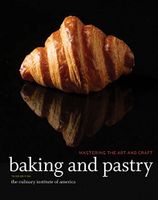Advertisement
Melting Chocolate
Appears in
By Culinary Institute of America
Published 2015
- Chocolate that is to be melted should be finely chopped. The smaller the pieces, the more surface area is exposed, and the quicker the chocolate melts, helping to prevent overheating. This is an important consideration, as overheating chocolate will render it unusable. A heavy chef’s knife is generally best for chopping chocolate, but some pastry chefs prefer to use a long serrated knife because the serrated blade breaks the chocolate into fine shards ideal for melting.
- A hot water bath is usually used for melting chocolate, but it is important that moisture (steam, water, or condensation) never comes in contact with the chocolate. Moisture causes chocolate to “seize,” or to become thick and grainy, rendering it unfit for tempering and most other uses. For this reason, it is important that the bowl (or the top of the double boiler) is completely dry and that the bowl (or top) fits snugly over the pan of water, forming a tight seal.
- The water should be steaming hot but not simmering.
- Gently stir the chocolate occasionally as it melts. Gently stirring the chocolate ensures even heating and melting.
- Remove the chocolate from the heat promptly once it is fully melted. Removing the chocolate promptly will keep the chocolate from becoming overheated.


